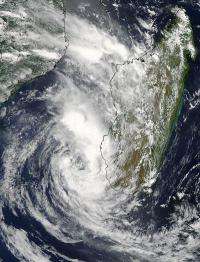NASA sees Cyclone Giovanna enter the Mozambique Channel

Cyclone Giovanna crossed over the island of Madagascar leaving flooding and damages in its wake and has now entered the Mozambique Channel. NASA's Aqua satellite captured an image that showed a ragged eye still exists, and the storm is regaining strength in the warm Channel waters.
Once Giovanna traversed the island nation of Madagascar and entered the Mozambique Channel, the body of water between Madagascar and Mozambique on the African mainland, NASA's Aqua satellite passed overhead and captured a visible image with the Moderate Resolution Imaging Spectroradiometer (MODIS) instrument.
MODIS captured the image at 10:45 UTC (5:45 a.m. EST) on February 15. The image showed that convection (rising air that forms the thunderstorms that make up the storm) had diminished greatly in the northwestern quadrant of the storm,. The MODIS image also showed that thunderstorms were now building around the rest of the tropical storm as a result ove moving into the warm waters of the Mozambique Channel. Sea surface temperatures of at least 80 Fahrenheit (26.6 Celsius) are needed to maintain a tropical cyclone, and temperatures in the Channel are as warm as ~88 Fahrenheit (31 Celsius).
On February 15, 2012 at 0300 UTC (Feb. 14 at 10 p.m. EST), Tropical Storm Giovanna's maximum sustained winds were near 40 knots (46 mph/74 kph). Tropical Cyclone Giovanna's center was located approximately 250 nautical miles west-southwest of Antananarivo, Madagascar, near 20.8 South and 42.4 East. It is moving to the west-southwest at 13 knots (15 mph/24 kph).
BBC News reports that at least two people died from storm related incidents, and the town Vatomandry, south of where Giovanna made landfall in east-central Madagascar, has experienced a lot of damage. BBC News reports that at least 60 percent of homes in the town were damaged or destroyed. Trees, phone and power lines have been downed, especially in eastern areas, as recovery efforts continue.
The Joint Typhoon Warning Center uses satellite data and forecast computer models to create forecasts. The current forecast for Giovanna now takes it on a westerly track toward Mozambique by the week's end. The forecast also indicates that wind shear will increase, which will prevent the storm from strengthening further. Residents along the southeastern coast of Mozambique should monitor the path of this tropical storm.
Provided by NASA's Goddard Space Flight Center



















